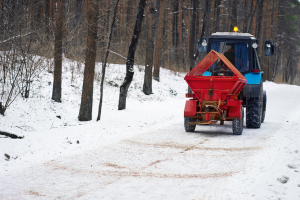by Andres Clavier, Freshwater Stewardship Education Intern
In cold climates, icy roads, pathways, and parking lots have traditionally been navigable thanks to salt. As environmental awareness grows, so does the quest for more ecologically kind alternatives. Although a multitude of alternatives have been tested, finding a universally accepted replacement has remained a challenge. In this blog, we will summarize some of the alternatives that are being tested and used around the world, and discuss some of their respective downsides.
Organic De-icers
Derived from agricultural waste, beet juice and cheese brine are utilized in regions like Ohio and Wisconsin, United States of America to depress the freezing point of water, enhancing salt efficiency. Yet, these may increase nutrient runoff, potentially amplifying algal blooms and related water quality issues. These de-icers require further testing before wide-scale use is possible. This research would evaluate whether or not they produce similar, or even higher, toxicity levels compared to traditional salts.
Traction Agents: Sand and Ash
Sand and ash, prevalent in countries like Sweden and Finland, provide immediate traction. However, they introduce environmental concerns including sedimentation and stormwater system obstruction.

Geothermal Heated Pavements
Certain municipalities, such as Reykjavik, Iceland and Holland, Michigan, utilize geothermal energy to melt snow on driveways, roads, and pavements. This solution can be costly and limited to where geothermal outputs are available.
Liquid Calcium Magnesium Acetate
Calcium Magnesium Acetate is an outcome of limestone and acetic acid reactions and has been recognized as an eco-friendly de-icing alternative. Despite its environmental benefits, its high cost renders it less favourable.
Technologically Enhanced Plowing
Japan employs trucks with integrated global positioning system (GPS) and sensors for real-time on-the-ground condition analysis, optimizing plowing and minimizing salt use.
Every alternative to salts presents distinct challenges. While innovative solutions emerge, potential environmental consequences of some alternatives persist. The inadvertent addition of nutrients to aquatic ecosystems or habitat disturbances exemplifies unforeseen ecological challenges. The emphasis on mitigating salt pollution implies that substituting other materials is insufficient. It is also important to be diligent in researching any claims of eco-friendly salt, and the lack of warning labels on salt bags that talk about environmental or health related risks. A comprehensive strategy, fusing innovative methods with efficient stormwater management and a dedication to reducing overall salt application, is pivotal. Balancing safety with ecological preservation requires continued research, public education, and policy evolution.
Watersheds Canada is initiating an education awareness campaign to protect our freshwater ecosystems from salt pollution. By supporting regulations, monitoring, and liability, we can safeguard our aquatic ecosystems, protect wildlife, and ensure the continued safety of our nation’s fresh waters. Your action could be the ripple effect needed to spark change! Share this awareness campaign with those in your network and community as we all join hands against salt pollution.
References
Echols, S. L., & Hanbali, R. M. (1999). Geothermal Snow Melting and Space Heating: An Energy- and Cost-Effective Application for Airports. The Leading Edge, 18(10), 1180-1183.
Göransson, M. (2002). Sanding, Salting and Traction Control – A Literature Review. VTI Report, 483A.
Howard, K.W.F., Haynes, J. Urban Geology (1993). 3: Groundwater Contamination due to Road De-icing Chemicals – Salt Balance Implications. Geoscience Canada. 20:1:1-8.
Nixon, W. A. (1997). The use of calcium magnesium acetate as a road salt substitute. Journal of Environmental Management, 49(2), 205-217.
Okitsu, S., Taniguchi, M., & Tanaka, S. (2011). ITS-based snow removal system in Hokkaido. ITS World Congress.
This piece is part of an education toolkit generously funded by:



Beyond road salt – tire particles from vehicles on our local highways is impacting our waterways. Tire manufacturers have to step to the plate. The advent of Bill 23 is allowing more subdivisions and with that comes more vehicles.